Abstract
Urban development and climate change have strengthened the possibility of floods and droughts in cities. In this study, we evaluated the influences of these disasters and related social damage in nine major basins during the past 50 years. Unusually, the following conclusions were drawn from the analysis of relevant indicators before and after urbanization: (1) agricultural loss area (flood), grain loss, and direct economic loss showed an upward trend, while other indicators showed the opposite. (2) Floods most often occur in the Yangtze River Basin (58, 26.2%), followed by the Liaohe River Basin (49, 22.2%), which is closely related to the topography and economic progress of the area. (3) The modified Mann–Kendall (MK) analysis results are consistent with the indicators trend. Finally, the regularity of the climate change and urbanization process is revealed by the migration of the standard deviation ellipse and the mean center of the four indicators. China needs to integrate urban water/drought policy development with sustainable urbanization policy development to cope with the changing natural and social environment and to minimize urban ecological risks.
1. Introduction
The causes of global warming and extreme climate disasters lie in the growth of urbanization rate and the rapid development of industry. According to the United Nations’ statistics, global population expansion mainly occurs in urban areas, while rural areas are relatively stable [1]. China, the world’s most populous country, has been urbanizing at an unprecedented rate since the reform and opening up. Meanwhile, the economy and society in China have developed rapidly during rapid social transformation, becoming one of the few countries where urban population growth exceeds total growth while rural population growth has been steadily declining [2,3]. In 2013, China’s urban population ratio surpassed the world average for the first time. Urbanization in 2020 (64%) was 3.6 times more than in 1978 (18%), with the current growth rate at approximately 20 million people per year [4].
Global urbanization has aided the development of people from all walks of life. The lack of relevant protection regulations has aggravated the deterioration of the urban environment and climate, especially in floods and droughts. Excessive urbanization has the most direct impact on land-use mode (more construction land, less permeable area) and infrastructure imperfections [5]. To our knowledge, few studies have simultaneously considered the impact of climate hazards on Chinese society before and after urbanization. Chou et al. assessed the effects of disasters (floods, droughts, and heat waves) on urban vulnerability based on different social scenarios and the AHP method [6]. Duan et al. conducted a spatiotemporal review of changes in flooding and associated socioeconomic losses in China over the past century. According to the findings, flash floods have become the leading cause of fatalities in recent decades due to fluctuations in extreme precipitation events [7]. Wang et al. proposed that persistent, complex, and changeable water resource challenges in China have led to severe conversation and management of the water environment. Uncontrolled urbanization has also had a negative influence on the global climate environment, making extreme weather frequent [8].
Floods and droughts are water-related disasters that take lives and cause economic losses. There are numerous cases, such as the “Century Flood” in Central Europe in 2013, extra heavy rainstorms in Zhengzhou in July 2021, China, the Amazon Drought in 2010, and the Cape Town water crisis in 2015–2018 [9,10]. Since 2000, climate change has intensified many record-breaking precipitation events, resulting in strong urban rainstorms and floods, paralyzing cities around the world, including Prague (2002), Dresden (2002), Seoul (2011), and Beijing (2012) [11,12]. In addition, during the 10 years from 2011 to 2020, the drought in South America was severe and persistent, especially involving Brazil, Argentina, Uruguay, Paraguay, Bolivia, Chile, Colombia, and Venezuela [13]. Throughout recent years, the worldwide financial harms resulting from floods and droughts are north of USD 2440 billion. In the case of China, the economic losses caused by floods accounted for about 2% of the total GDP in the 40 years (1980–2020), and the total number of people affected reached more than 200 million, including deaths, injuries, and homeless. The all-out economic misfortune brought about by the dry season has represented over 0.32% of GDP in the past 40 years, and the impacted population is around a 51million [14]. Somewhere in the range of 2000 and 2020, South Asia alone experienced 11% of the world’s climate hazards and 12% of floods and droughts disasters, affecting over 700 million people and 190 million ha of agricultural land [13]. These disasters related to the water environment have had profound impacts on society, the environment, and the economy. One crucial aspect in mitigating the impacts of flood disasters lies in the development and implementation of robust emergency planning. Emergency planning assumes a pivotal role in bolstering community resilience, diminishing vulnerability, and mitigating the adverse consequences of floods. By establishing proactive measures, including early warning systems, evacuation plans, and resource allocation strategies, emergency planning ensures expeditious and efficient responses to flood events. Consequently, this research has explored the cause of floods and droughts and contributed to the formulation of disaster management policies [15].
Creatively, based on the change in floods and drought losses during urbanization, the ultimate goal of this study is to evaluate the distribution and trend of socio-economic losses. Meanwhile, the modified Mann–Kendall (MK) trend Z-value test and analysis are verified. Specifically, we use the combination of statistical methods and the GIS system to describe the impact of disaster trend changes on Chinese society, including population, housing destruction, agricultural production reduction, and direct economic losses. Finally, we analyze the impact and causes of disasters by discussing the patterns of changes in the standard deviation ellipse (SDE) and the migration of the mean center (MC) of the four indicators related to climate change and urban development.
2. Data and Method
2.1. Frame
Figure 1 shows the framework of this study. Six indicators have been selected to study the social impact of climate disasters (flood and drought) on China. Simultaneously, 1970–2020 is selected as the research interval to consider the development of the urbanization process, and 1995 is picked as the sudden change point. In addition, the relevant results were verified by the modified MK trend test. Finally, the paper discusses the causes of the changes in impact on Chinese society and draws appropriate conclusions.
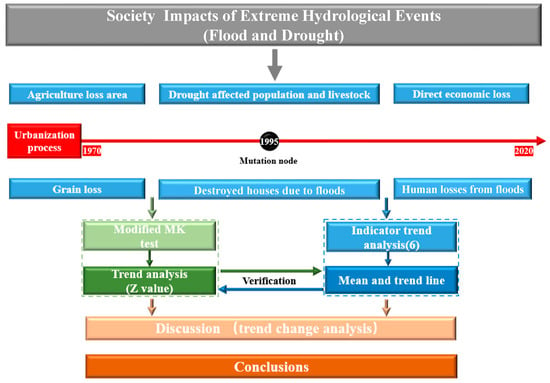
Figure 1.
Research frame.
2.2. Data Sources
The data used in this study are primarily from the China Flood and Drought Disaster Prevention Bulletin, which is compiled by China’s Ministry of Water Resources (http://www.mwr.gov.cn, accessed on 3 August 2023) and the Bureau of Statistics’ Statistical Yearbook (http://www.stats.gov.cn, accessed on 3 August 2023). The data on urbanization rate, flood and drought disasters, economic losses, etc., used in the current effort are from these two institutions. It is worth noting that floods in this study include not only traditional urban floods caused by heavy precipitation but also water disasters caused by melting ice and snow, dam breaks, and storms.
2.3. Methods
Via sorting, we input the floods and droughts data (e.g., occurrence time, frequency and loss, etc.) into the Excel database file. Pattern examination was finished utilizing Kendall’s Tau test for monotonic patterns to decide if genuinely significant trends exist in disasters and related financial harms through time. The Mann–Kendall test is a nonparametric test. It has the advantage of not requiring samples to follow a specific distribution and is not affected by a few outliers, making it more suitable for type and sequence variables, and the calculation is relatively simple and accurate [16]. Generally, the Mann–Kendall trend test can be expressed most commonly as a test for whether Y values will generally increment or reduce with T (X values). The relevant computing processes are as follows:
where Tj and Ti are the precipitation changeability at numerous time scales j and i, respectively. When n 10, the measurement S is around ordinarily distributed with the mean and variance as follows:
where ti denotes the number of ties to extent i. The summation term in the numerator is utilized, provided that the information series contains tied qualities. The standard test measurement ZS is determined as follows:
Parameter Zs is used in statistics to measure the significance of trend changes and to test the null hypothesis in statistics (generally assumed that it is not significant). If |Zs| is greater than Zα/2, where α is the meaning of the significance level (e.g., α = 5% then Z0.025 = 1.96) then the null hypothesis is invalid, inferring that the trend is significant.
3. Result
3.1. Modified Mann–Kendall Test
The nonparametric Mann–Kendall (MK) statistical test is commonly used to assess the significance of trends in hydrological time series. This test requires serial and independent sample data. The presence of sequence correlation in the time series will affect the ability of the test to correctly evaluate the significance of the trend when the sample data is sequence correlation. Yue and Wang proposed a prewhitening method to eliminate the influence of serial correlation on the Mann–Kendall test [16,17].
Figure 2 shows the Z value of the modified MK test for disaster-related socio-economic losses. The results indicated that the significant test results were consistent at a 95% confidence level, and the Z values of agricultural loss area (flood), grain loss, and direct economic loss were greater than 0, showing a positive correlation; the Z values of the other parameters were less than 0, showing a negative correlation.
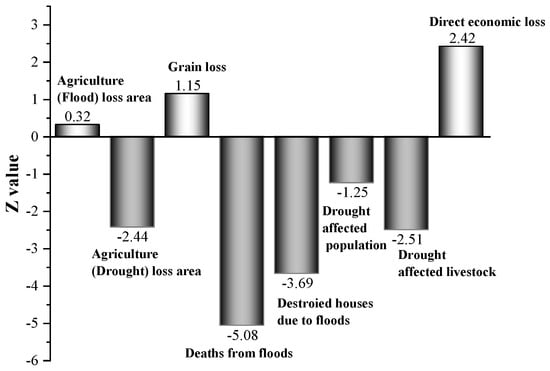
Figure 2.
Modified MK inspection results.
3.2. Urbanization Process Analysis
Surface runoff is frequently a critical factor in the occurrence of urban floods, and excessive urbanization directly leads to changes in the urban underlying surface. Impermeable area increases surface runoff, thus increasing the occurrence of urban floods [18,19]. Urban floods are caused by human activities and natural phenomena, which have complex spatial characteristics. With the advancement of research into the hydrological effect mechanism of urbanization, the focus has shifted from the growth of impermeable rate to the change mechanism of the hydrological characteristic curve that extends deep into the surface [20]. Therefore, we can explain how urbanization affects the occurrence of urban floods in recent years using the runoff process curve before and after the urbanization rate and underlying surface. Meanwhile, the expanding urbanization is used as a time node to lay the groundwork for the paper’s subsequent analysis [21].
From the black box in Figure 3, we can explicitly see that China’s overall urbanization rate is on the rise as a whole and began to grow rapidly after 1995. As a result, we have calculated the average value of China’s urbanization rate from 1970 to 1995 and from 1996 to 2020 as a time node, which is represented by the blue and green lines, respectively. In addition, a purple line represents the overall average value of the urbanization rate. We will use 1995 as a time node to analyze the relevant contents in the subsequent disasters of urban floods and droughts.
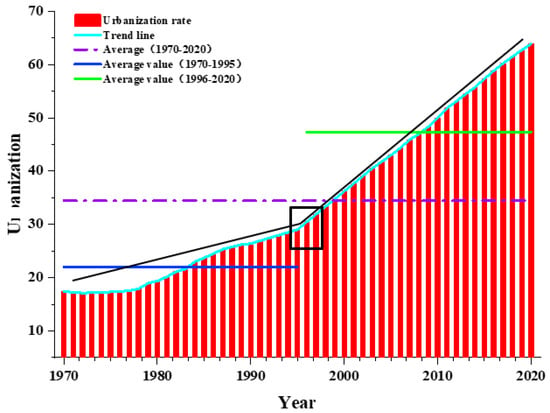
Figure 3.
Urbanization process in China (1970–2020).
Figure 4 shows the theoretical curve of the underlying surface runoff process before and after urbanization. It is not difficult to find that the runoff hydrograph changes from “short and fat” to “tall and thin” before and after urbanization, implying that the surface interception and infiltration amount are significantly reduced. Furthermore, the urban surface roughness decreases, which accelerates surface convergence, increases surface flow and flood peak, and advances flood occurrence time.

Figure 4.
Theoretical curve of runoff change (before and after urbanization).
3.3. Spatial and Temporal Distribution of Flood
Depending on the extent of the flood damage, we divide it into three levels (L1, 5-year, L2, 10-year, and L3, 20-year return periods), and make statistics on the flood occurrence in all large basins in China (Figure 5). In recent years, there have been 221 floods of different degrees in the nine major river basins in China, including 31, 56, and 134 floods of L3, L2, and L1, respectively. There were 58 floods in the Yangtze River Basin, accounting for 26.2% of the total floods, followed by Yangtze River Basin (58, 26.2%), Songhua and Liaohe River Basin (49, 22.2%), Huaihe River Basin (27, 12.2%), Haihe River Basin (26, 11.8%), and Pearl River Basin (26, 11.8%). The frequency of floods in the Continental Basin and Southwest Basin is low, and no relevant data is collected, so the figure does not depict it.
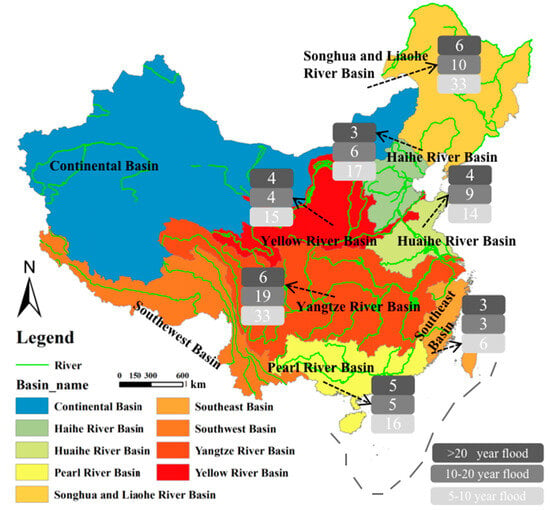
Figure 5.
Distribution of three grades of the flood (L1, L2, and L3).
L3 and L1 floods are the most common in the Songhua and Liaohe River Basins, as well as the Yangtze River Basin. Meanwhile, these two basins correspond to two main plains, the Yangtze River Plain and the Sanjiang Plain, suggesting that disastrous floods are typically concentrated in wide and even areas. In addition, we have examined the urbanization level of cities in the basin over the past 15 years and listed them in Table 1. Surprisingly, the Haihe River Basin and the Southeast River Basin rank the first two in terms of urbanization level. Considering the geographical location, the Haihe River Basin and the Southeast River Basin are located on China’s topographic map in the third step. Generally speaking, the terrain is flat and close to the coast, and the flood is prone to discharge.

Table 1.
Urbanization level of nine major river basins.
3.4. Impact on Agricultural Production
Figure 6a shows the loss of area caused by floods disasters to China’s agriculture in the past 50 years. We examined the agricultural loss area using 1995 as the time node, as stated in Section 3.2. The blue and green lines in Figure 6a represent the average loss of the two periods (1970–1995 and 1995–2020), respectively. The data show that after significant changes in urbanization, the losses caused by floods to agriculture are far greater than those in the period with a low urbanization level. Meanwhile, this also conforms to the inspection results (Z = 0.32) of the modified MK trend analysis in Section 3.1.
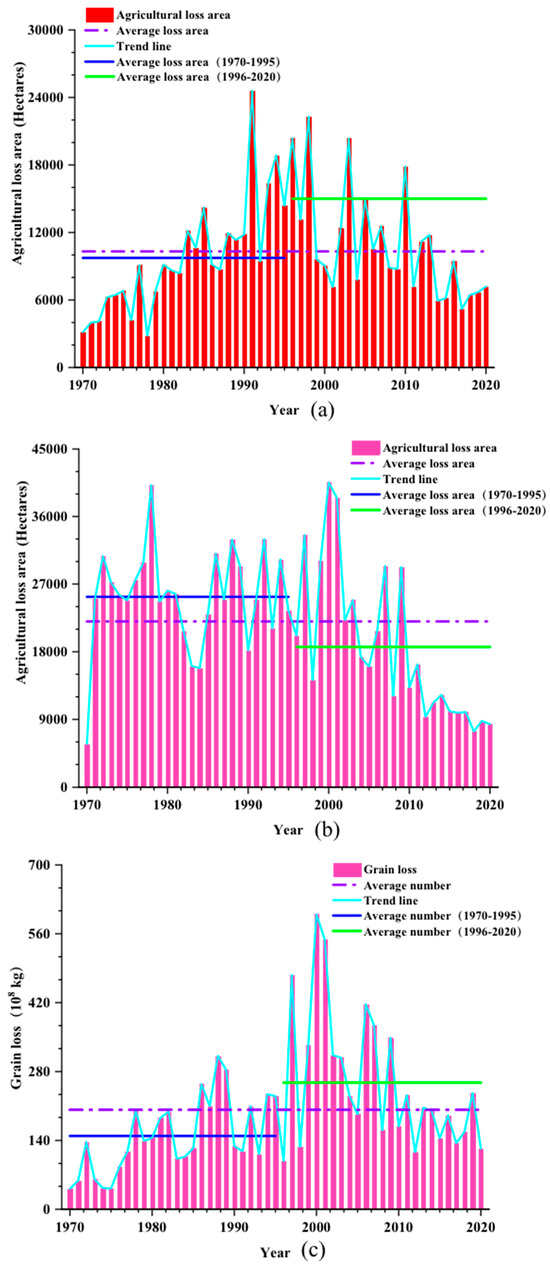
Figure 6.
Changes in the impact of floods and droughts on society, (a) agricultural loss area (flood), (b) agricultural loss area (drought), and (c) grain loss (drought). (The light blue line here cannot be seen as a reflection of the general trend of variable changes. More precisely, it is a trend line chart that reflects changes in the bar chart).
Figure 6b,c describe the impact of drought on China’s agriculture, mainly in terms of the agricultural impact area and grain loss (Red stands for floods, pink for droughts). Similarly, we discussed the situation around 1995. It can be seen in Figure 6b that the trend line of the agricultural loss area shows a declining change, and the average loss from 1995 to 2020 is lower than before 1995. It is, however, shown in Figure 6c that drought-related grain loss increased after 1995 with an upward trend. Indeed, the results shown in Figure 6b,c do not contradict each other. We attribute this phenomenon to advances in agricultural technology and the introduction of new breeds. In other words, these factors have increased output per unit area.
3.5. Population and Housing Losses
This section focuses on the impact and trend of floods and droughts on population, houses, and livestock. Figure 7a shows that 1975 was the year with the largest flood-affected population, with approximately 30,000 deaths nationwide. The number of casualties in 1975 caused by floods decreased steadily. Since the significant changes in urbanization in 1995, in particular, the death toll from floods has remained low (Consistent with the results of the modified MK analysis Z-value test in Section 3.1). Based on the relevant literature, we summarized the following possibilities: (1) the level of urbanization has increased, and advances in early warning and forecasting of urban floods have resulted in people being able to relocate to safe areas before floods occur. (2) the government is constantly improving emergency response measures for urban floods so that it can respond to emergencies promptly. (3) While urban flooding still occurs, the level of hazard has been greatly reduced due to the development of sponge cities and LID measures.
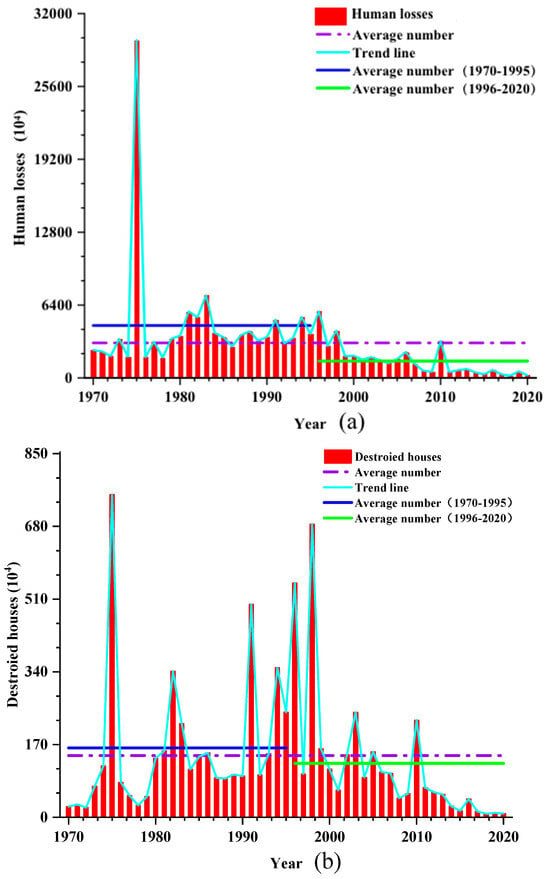
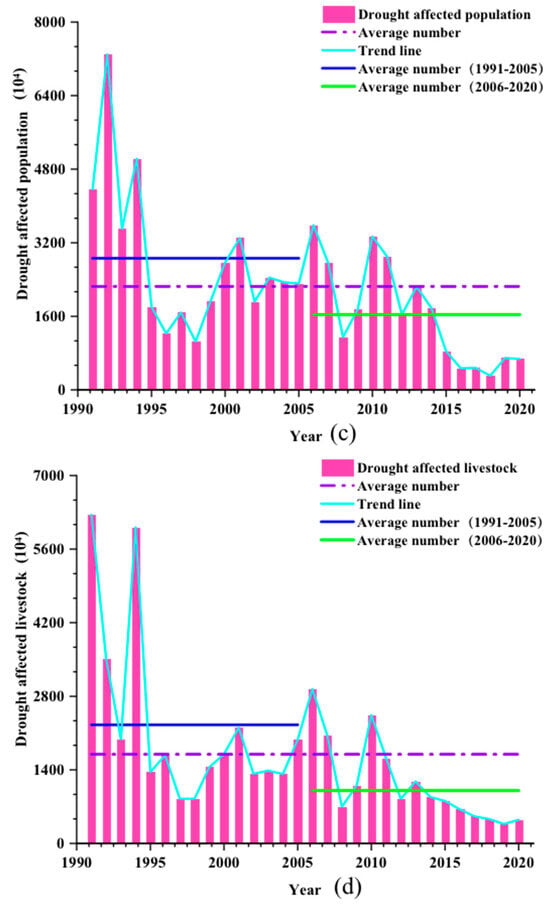
Figure 7.
Changes in the impact of floods and droughts on society, (a) human losses, (b) destroyed houses, (c) drought-affected population, and (d) drought-affected livestock.
In general, flood damage to houses occurs more frequently in rural areas and less frequently in areas with higher levels of urbanization. This conclusion is reflected in Figure 7b. Since 1995, the number of houses damaged by floods has been diminishing steadily (Z = −3.69). In 1975, during a period of low urbanization, the number of houses destroyed by floods reached 754 × 104. The basic trend is consistent with the Z-value test results in Section 3.1, but another conclusion can be drawn from the modified MK trend analysis. The number of houses damaged by floods is decreasing but at a slower rate.
Due to a lack of drought disaster data, only the occurrence trend over the last 30 years is examined. The impact of drought on both population (Z = −1.25) and livestock (Z = −2.51) is decreasing, as shown in Figure 7c,d. The most likely reason is that the state is focusing more on water resource ecological protection and the construction of China’s South-to-North Water Diversion Project. The distribution of water resources is thus balanced.
3.6. Obstacles to Social and Economic Development
Figure 8 depicts the direct economic losses caused by floods and their proportion to GDP from 1990 to 2020. Direct economic losses have risen over the last 30 years. The average direct economic loss caused by flooding is greater during periods of high urbanization. This is primarily because the damage caused by floods is becoming increasingly severe as cities develop. The most direct economic damage occurred in 2010 and 2016, totaling up to 374.5 billion Yuan and 364.3 billion Yuan, respectively. Instead, the GDP proportion has been declining since 1997. From the standpoint of national economic development, this is most likely due to China’s recent rapid reform.
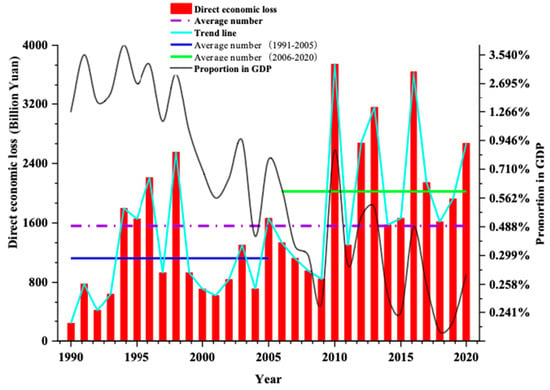
Figure 8.
Direct economic loss caused by flood and its proportion to GDP.
3.7. Distribution Situations
From 2006 to 2020, the spatial distribution of floods is expressed as an average of the affected population, industry, crop-affected area, and direct economic loss by province Figure 9a–d. The findings in these cases indicate that flood frequency increases primarily in plains with a high population along the Yangtze River, Sichuan, Guangdong, Hunan, and other regions with large reservoirs. In addition, Figure 9b depicts the average industrial shutdown caused by floods in China. It is straightforward to observe how this change gradually decreases from coastal cities to inland, and industries in Guangdong and Zhejiang are the most vulnerable to floods since industries in coastal cities are generally more developed. Furthermore, as illustrated in Figure 9c,d, floods and droughts appear to be significant driving factors that cause grain and economic losses every year, primarily in Heilongjiang, Guangdong, Jiangxi, Zhejiang, and other agricultural and economically developed areas.
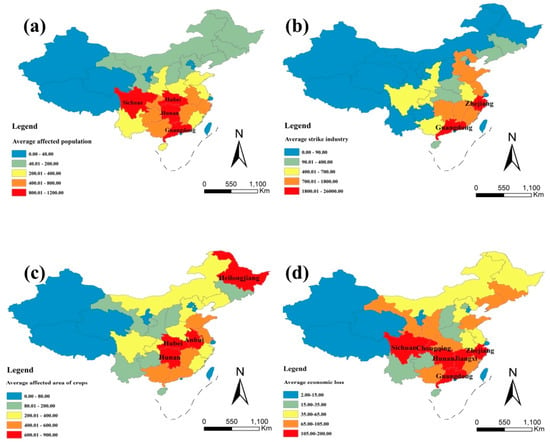
Figure 9.
Average distribution of disaster losses in each province (2006–2020), (a) average affected population, (b) average strike industry, (c) average affected area of crops, and (d) average economic loss.
4. Discussion
4.1. Impact of Indicator Changes on Floods and Droughts
Rising temperatures and increasing rainfall are the main features of climate change. The average temperature in China has shown an increasing trend, rising by about 0.5–0.8 °C over the last almost 20 years [22,23]. According to the principle of specific heat capacity in physics, cold regions, and land surfaces are warming faster and more than warm regions and water surfaces. At the same time, the temperature increase due to climate change will show a migration pattern in space with time. This characteristic directly affects the stability of the hydrological cycle, leading to sea level rise, changing the regional water balance and regional water distribution patterns, and increasing the probability of extreme hydrological events (extreme rainfall and drought).
As can be seen in Figure 10a,b, the average centers of temperature and rainfall indicators are concentrated along the Yangtze River basin in China. In Figure 10a, the center of the standard deviation ellipse is shifted to the north, and the standard deviation changes insignificantly. In Figure 10b, the center of the standard deviation ellipse of rainfall indicators is shifted from Hunan Province to Hubei Province, and the migration trend is obvious. The migration of the rainfall center is limited but still revolves around the Yangtze River basin area. This is consistent with the results of flood distribution in Section 3.3 (rank 1 in flood occurrence in the Yangtze River basin).
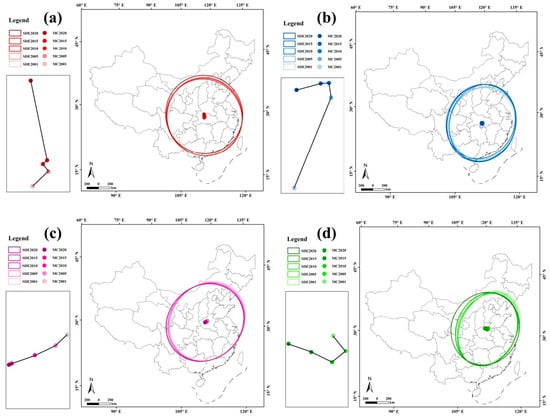
Figure 10.
Patterns of indicator changes during climate change and urbanization over the past 20 years, (a) average temperature change, (b) average precipitation variation, (c) change in urbanization rate, (d) change in carbon emissions. (SDE, standard deviation ellipse. MC, mean center).
In terms of the urbanization process, it is primarily reflected in two aspects: carbon emissions and urbanization rate. Generally speaking, the higher the level of economic development and the urbanization rate, the higher the carbon emissions. Correspondingly, impervious surfaces, etc., in cities will also increase. However, as the construction of urban drainage facilities lags behind the development of cities, a series of urban flooding problems have arisen. In Figure 10c,d, the migration patterns of urbanization and carbon emissions for each province in China are shown. From Figure 10c, it is clear that the mean center of the standard deviation ellipse of urbanization keeps migrating to the west. There are irregular changes in the standard deviation ellipse of carbon emissions in Figure 10d, but overall, it is also migrating to the western provinces, which is closely related to China’s western development strategy in recent years. However, China’s urbanization process still has a long way to go, and considering the future changes in China’s policies and development philosophy, it is difficult to assess the impact of the current urbanization changes on floods and droughts hazards alone.
4.2. Cause Analysis of Floods and Droughts
Flood statistical analysis shows that direct economic loss and agricultural area loss tend to increase, particularly during periods of high urbanization, and that the majority of these losses are concentrated in a few relatively developed river basins in China, such as the Yangtze River and the Pearl River Basin. Drought disasters have also increased in previous years. We summarized the following reasons after reviewing relevant literature:
Firstly, global climate change has increased extreme disasters such as floods and droughts in recent years. Furthermore, human activities are a significant driver. Many studies show that seasonal rainfall in China has become painfully evident in recent decades, affecting the hydrological cycle and leading to disasters with strong seasonal characteristics. Song et al. discovered that the number of days with precipitation of more than 50 mm is increasing in most parts of Southeast China, which is important for people’s daily lives as well as social and economic development [24]. According to Jiang et al., frequent extreme precipitation in summer exacerbates floods in the middle and lower reaches of the Yangtze River and other river basins, whereas low precipitation in winter generally causes drought disasters [25].
Secondly, changes in urbanization, land use patterns, and residential water consumption not only have a significant impact on urban hydrological processes but also exacerbate natural disaster risks such as floods and droughts [26]. Furthermore, China faces ongoing, multifaceted, and critical water resource challenges, making water resource management and protection extremely difficult. For example, the increased impermeable surface often results in greater runoff and earlier peak discharge, giving rise to urban flooding; increasing urban population raises the risk of drought disaster. As a result, urbanized areas have become vulnerable, resulting in massive economic losses and casualties.
Thirdly, the occurrence of floods and droughts in China’s nine major river basins follows a distinct spatial pattern. Climate, topography, geomorphology, and population density all influence how vulnerable Chinese cities are to floods and droughts [27]. Cities in China’s east, south, and northeast are primarily located in flooded areas and along the banks of the seven major rivers. Cities in northern and northwestern China, on the other hand, are mostly concentrated in the North China Plain, the Inner Mongolia Plateau, the Loess Plateau, and the Tarim Basin. These areas are typically semi-arid or arid, with annual precipitation totaling less than 500 mm or even 200 mm.
China’s urbanization is extremely rapid, with approximately 20 million rural people flowing into cities each year, most of them residing in flood-prone plains. Consequently, there exists a demand for solutions to control or minimize floods and droughts risks in China’s cities under the pressure of urbanization and climate change.
4.3. Suggestions for Mitigating Climate Disaster Losses
Each country encounters unique climate challenges. However, by employing comprehensive governance strategies and innovative technologies, cities can effectively tackle the issues of floods and droughts, ultimately establishing more resilient and adaptable urban areas.
4.3.1. Urban Planning and Design
Adopting the concepts of natural capital and ecosystem services in urban planning and design, emphasizing the protection and restoration, such as wetlands, forests, rivers, and coastlines, to effectively absorb floods, increase water resource storage, and provide protection. Via the concept of ecosystem services, the functions of natural systems (such as natural filtration, hydrological regulation, and soil protection) are incorporated into urban planning and design processes, such as strengthening urban drainage systems, constructing ecological engineering, and strengthening river control and remediation. In addition, it is advocated to strengthen the connections between various departments within the city. By collaborating with departments such as urban planning, water management, and environmental protection, cities can integrate climate change adaptation into their overall sustainable development strategy. This ensures the long-term sustainability of urban planning and enables collective efforts to address the challenges posed by climate change. Meanwhile, encouraging public participation in urban planning and design processes is also crucial in enhancing the resilience and adaptability of cities during disasters. It is important to acknowledge that addressing the challenges of climate change is a multifaceted and multi-level process that demands comprehensive consideration of various factors. Consequently, response strategies for urban planning and design should be tailored to specific geographical, social, and economic conditions, taking into account the unique characteristics of each location.
4.3.2. Technology and Innovation
Technological innovation plays a crucial role in addressing the challenges of floods and droughts in urban development and climate change. By employing machine learning algorithms, advanced hydrological models and warning systems can be established, enabling effective analysis of various factors such as historical flood data, terrain, and meteorological data. Simultaneously, real-time flood monitoring and early warning systems can be implemented, allowing proactive measures to mitigate the impact of floods on cities [28]. Machine learning algorithms are also being increasingly applied in drought adaptation technology. The establishment of intelligent irrigation models, utilizing remote sensing data, meteorological data, and soil moisture data, can assist agricultural departments and water resource management institutions in reducing water wastage and responding to unforeseen drought disasters. Technological innovation holds immense potential in addressing the challenges of floods and droughts in urban development and climate change [29]. By continuously advancing technological progress, we can effectively confront the repercussions of climate-related disasters and achieve sustainable development.
5. Conclusions
This paper examines floods and droughts in China over the last century, as well as the socioeconomic consequences. According to the findings, the 5–10-year flood is the most common cause of flood disasters in China in recent years. After correction, the data analysis results are essentially consistent with the modified MK trend test analysis. Agricultural loss area (flood), grain loss, and direct economic loss increased; other indicators decreased (agricultural loss area (flood), Z = 0.32; (drought), Z = −2.44; grain loss, Z = 1.15; direct economic loss, Z = 2.42; human losses from floods, Z = −5.08; destroyed houses, Z = −3.69; drought-affected population and livestock, Z = −1.25, −2.51). China’s urban flood problem is massive, and its population impact is far greater than the drought problem. In total, 25.1 million people live in flood-prone areas, and 8 million live in areas with extremely high drought severity. Floods most often occur in the Yangtze River Basin (58, 26.2%), followed by the Liaohe River Basin (49, 22.2%), which is closely related to the topography and economic progress of the area. Meanwhile, the effects of floods and droughts were analyzed by discussing the migration patterns of the standard deviation ellipses and mean centers of the four indicators. In a nutshell, China’s rapid development is a two-edged sword, with an expanding urban economic center and a shrinking ecological environmental capacity. Approximately half of new urban residents live in developed cities that are vulnerable to droughts and floods, particularly the latter. We have taken a step toward quantifying this complex issue and providing a deeper understanding of the main policies guiding China’s development via this analysis.
Author Contributions
Conceptualization, P.L.; Methodology, Y.L., R.Y., P.L., Z.L., S.W. and X.Z.; Software, Y.L. and Z.L.; Validation, Y.L., R.Y., S.W. and W.Z.; Formal analysis, R.Y. and Y.S.; Investigation, Y.S. and W.Z.; Resources, X.Z.; Writing—original draft, Y.M.; Writing—review & editing, Y.M., Y.L., R.Y., Z.L. and Y.S.; Visualization, Y.L.; Supervision, Y.L., P.L. and S.W. All authors have read and agreed to the published version of the manuscript.
Funding
Financial support is given by National Key R&D Program of China (2018YFE0103800), China Scholarship Council (Grant No.: Liujinmei [2022] No. 45), International Education Research Program of Chang’an University (300108221102), General Project of Shaanxi Provincial Key R&D Program—Social Development Field (2021SF-454), and GDAS Special Project of Science and Technology Development (2020GDASYL-20200102013).
Institutional Review Board Statement
Not applicable.
Informed Consent Statement
Informed consent was obtained from all subjects involved in the study.
Data Availability Statement
The data presented in this study are available on request from the corresponding author.
Conflicts of Interest
Author Yong Mu, Ying Li, Ran Yan, Zhe Liu, Yingying Sun, were employed by the Shaanxi Provincial Land Engineering Construction Group Corporation. The remaining authors declare that the research was conducted in the absence of any commercial or financial relationships that could be construed as a potential conflict of interest.
References
- United Nations. Population of Urban Agglomerations with 300,000 Inhabitants or More in 2014, by Country, 1950–2030 (Thousands). 2014. Available online: https://esa.un.org/unpd/wup/CD-ROM/WUP2014_XLS_CD_FILES/WUP2014-F12-Cities_Over_300K.xls (accessed on 10 August 2023).
- Luo, P.P.; Mu, Y.; Wang, S.T.; Zhu, W.; Mishra, B.K.; Huo, A.D.; Zhou, M.M.; Lyu, J.Q.; Hu, M.C.; Duan, W.L.; et al. Exploring sustainable solutions for the water environment in Chinese and Southeast Asian cities. Ambio 2022, 51, 1199–1218. [Google Scholar] [CrossRef] [PubMed]
- Xu, Y.Z.; Zhang, R.J.; Fan, X.M.; Wang, Q.T. How does green technology innovation affect urbanization? An empirical study from provinces of China. Environ. Sci. Pollut. Res. 2022, 29, 36626–36639. [Google Scholar] [CrossRef] [PubMed]
- Gong, Y.; Wei, Y.N.; Gu, J.L. Urbanisation of the Chinese Rural Population: A Literature Review of China’s New-type Urbanisation. China Int. J. 2022, 20, 181–204. [Google Scholar] [CrossRef]
- Chai, K.C.; Ma, X.R.; Yang, Y.; Lu, Y.J.; Chang, K.C. The impact of climate change on population urbanization: Evidence from china. Front. Environ. Sci. 2022, 10, 8481–8491. [Google Scholar] [CrossRef]
- Chou, J.M.; Sun, M.Y.; Dong, W.J.; Zhao, W.X.; Li, J.N.; Li, Y.M.; Zhou, J.Y. Assessment and Prediction of Climate Risks in Three Major Urban Agglomerations of Eastern China. Sustainability 2021, 13, 13037. [Google Scholar] [CrossRef]
- Duan, W.L.; He, B.; Nover, D.; Fan, J.L.; Yang, G.S.; Chen, W.; Meng, H.F.; Liu, C.M. Floods and associated socioeconomic damages in China over the last century. Nat. Hazards 2016, 82, 401–413. [Google Scholar] [CrossRef]
- Li, X.; Hu, Q. Spatiotemporal Changes in Extreme Precipitation and Its Dependence on Topography over the Poyang Lake Basin, China. Adv. Meteorol. 2019, 2019, 1253932. [Google Scholar] [CrossRef]
- China Meterological Administration. Inventory: Extreme Heavy Rainfall and Flood Events in Recent Years. Available online: http://www.qxkp.net/zhfy/byhl/202103/t20210301_2791461.html (accessed on 16 March 2021).
- Lewis, S.L.; Brando, P.M.; Phillips, O.L.; van der Heijden, G.M.; Nepstad, D. The 2010 Amazon drought. Science 2011, 331, 554. [Google Scholar] [CrossRef]
- Coumou, D.; Rahmstorf, S. A decade of weather extremes. Nat. Clim. Chang. 2012, 2, 491–496. [Google Scholar] [CrossRef]
- Zhu, Z.H.; Chen, Z.H.; Chen, X.H.; He, P.Y. Approach for evaluating inundation risks in urban drainage systems. Sci. Total Environ. 2016, 553, 1–12. [Google Scholar] [CrossRef]
- Zhang, Q.; Han, L.; Zhang, L.; Wang, J. Analysis on the Character and Management Strategy of Drought Disaster and Risk under the Climatic Warming. Adv. Earth Sci. 2014, 29, 80–91. [Google Scholar]
- Ritchie, H. Natural Disasters. 2021. Available online: https://ourworldindata.org/natural-disasters#licence (accessed on 10 August 2023).
- Maranzoni, A.; D’Oria, M.; Rizzo, C. Quantitative flood hazard assessment methods: A review. J. Flood Risk Manag. 2023, 16, e12855. [Google Scholar] [CrossRef]
- Yue, S.; Wang, C.Y. The Mann-Kendall Test Modified by Effective Sample Size to Detect Trend in Serially Correlated Hydrological Series. Water Resour. Manag. Int. J. Publ. Eur. Water Resour. Assoc. (EWRA) 2004, 18, 201–218. [Google Scholar] [CrossRef]
- Yue, S.; Wang, C.Y. Applicability of prewhitening to eliminate the influence of serial correlation on the Mann-Kendall test. Water Resour. Res. 2002, 38, 41–47. [Google Scholar] [CrossRef]
- Gu, C.L. Urbanization: Processes and driving forces. Sci. China-Earth Sci. 2019, 62, 1351–1360. [Google Scholar] [CrossRef]
- McGrane, S.J. Impacts of urbanisation on hydrological and water quality dynamics, and urban water management: A review. Hydrol. Sci. J.—J. Sci. Hydrol. 2016, 61, 2295–2311. [Google Scholar] [CrossRef]
- Jiang, S.J.; Li, S.R.; Liu, G.W.; Zhou, L. The impacts of Infrastructure Investment on the Process of Urbanization. In International Symposium on Advancement of Construction Management and Real Estate; Asian Development Bank Institute: Nanjing, China, 2009; pp. 2425–2430. [Google Scholar]
- Guan, X.L.; Wei, H.K.; Lu, S.S.; Dai, Q.; Su, H.J. Assessment on the urbanization strategy in China: Achievements, challenges and reflections. Habitat Int. 2018, 71, 97–109. [Google Scholar] [CrossRef]
- Feng, A.; Chao, Q. An overview of assessment methods and analysis for climate change risk in China. Phys. Chem. Earth 2020, 117, 102861. [Google Scholar] [CrossRef]
- Zhao, R.; Li, X.; Wang, Y.; Xu, Z.C.; Xiong, M.Y.; Jia, Q.; Li, F.T. Assessing resilience of sustainability to climate change in China’s cities. Sci. Total Environ. 2023, 898, 165568. [Google Scholar] [CrossRef]
- Song, Y.; Achberger, C.; Linderholm, H.W. Rain-season trends in precipitation and their effect in different climate regions of China during 1961–2008. Environ. Res. Lett. 2011, 6, 329–346. [Google Scholar] [CrossRef]
- Jiang, T.; Kundzewicz, Z.W.; Su, B. Changes in monthly precipitation and flood hazard in the Yangtze River Basin, China. Int. J. Climatol. 2010, 28, 1471–1481. [Google Scholar] [CrossRef]
- Cao, Z.; Wang, S.; Luo, P.; Xie, D.; Zhu, W. Watershed Ecohydrological Processes in a Changing Environment: Opportunities and Challenges. Water 2022, 14, 1502. [Google Scholar] [CrossRef]
- Sy, B.; Frischknecht, C.; Dao, H.; Consuegra, D.; Giuliani, G. Flood hazard assessment and the role of citizen science. J. Flood Risk Manag. 2019, 12, e12519. [Google Scholar] [CrossRef]
- Asim, K.M.; Martínez-Álvarez, F.; Basit, A.; Iqbal, T. Earthquake magnitude prediction in Hindukush region using machine learning techniques. Nat. Hazards 2017, 85, 471–486. [Google Scholar] [CrossRef]
- Cheng, S.; Jin, Y.; Harrison, S.P.; Quilodrán-Casas, C.; Prentice, I.C.; Guo, Y.-K.; Arcucci, R. Parameter Flexible Wildfire Prediction Using Machine Learning Techniques: Forward and Inverse Modelling. Remote Sens. 2022, 14, 3228. [Google Scholar] [CrossRef]
Disclaimer/Publisher’s Note: The statements, opinions and data contained in all publications are solely those of the individual author(s) and contributor(s) and not of MDPI and/or the editor(s). MDPI and/or the editor(s) disclaim responsibility for any injury to people or property resulting from any ideas, methods, instructions or products referred to in the content. |
© 2023 by the authors. Licensee MDPI, Basel, Switzerland. This article is an open access article distributed under the terms and conditions of the Creative Commons Attribution (CC BY) license (https://creativecommons.org/licenses/by/4.0/).